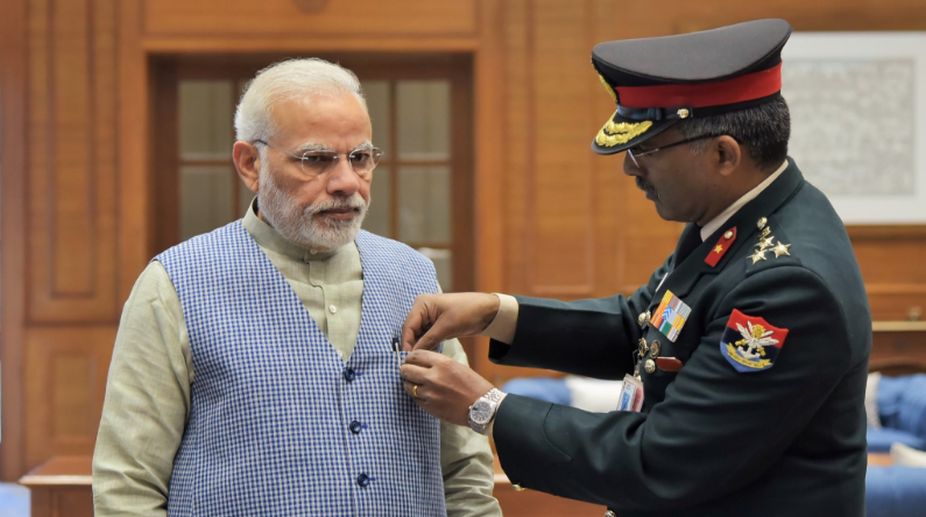CDS Chauhan calls for developing joint culture for armed forces
Inputs on national strategic issues impacting national security in both the civil and military domains were also deliberated upon.

(Photo: Twitter)
Information on the Armed Forces Flag day was for the first time well disseminated across the nation employing every medium, mainly social. While the event did get good coverage and possibly reasonable contributions flowed in, the very concept and methodology of the flag day needs a rethink. It has followed a laid down schedule since 1949, with an increased emphasis this year on employing digital media to enhance contributions.
It was first celebrated in 1949 on 7 December and has since become a ritual. There is no specific historical reason for the selection of this date except the fact that the Defence Ministers Committee in August 1949 took a decision to celebrate Armed forces flag day every year on 7 December. The nation had yet to face any major external threat, hence any day was suitable.
In the past, NCC cadets and volunteer schoolchildren would be visible at crossings with small donation boxes and flags. Motorists would stop to make their contributions and a flag would be pinned on them. The smile on the faces of young volunteers was enough to even melt the heart of people.
Advertisement
Now, there is no organised system of collection, hence the Flag day largely remains unknown. Photographs in newspapers on the next day invariably show a flag being pinned on the jacket of the state governor and chief minister.
In the present digital era, contributions can easily be made online. The funds collected on Flag day are employed for three principal tasks. Firstly, rehabilitation of families of battle casualties; secondly, welfare of serving personnel and finally for resettlement and well-being of ex-servicemen, including battle casualties. In addition to the Flag day, there is always an option for those seeking to donate for the welfare of armed forces personnel to deposit funds online to either the National Defence Fund or the Indian Army Welfare Fund.
In the initial years, the three services would hold a variety of traditional and cultural programmes, plays, festivals and other activities to showcase their unity in diversity on Flag day. This has taken a backseat and so have serious efforts at interacting with the common Indian. The day has largely remained ignored by the serving military community and the masses. With passage of time, even efforts at increasing public donations have reduced.
Collection of donations at national levels is coordinated by the Kendriya Sainik Boards (KSB). At state levels it is the Rajya Sainik Board (RSB) and Zila Sainik Boards, which are quasi-independent bodies and operate under the KSB at the central level. While advertisements are few for donations, this year however the government went on an overdrive on social media to enhance awareness amongst the public.
In the present era, there is a requirement to reconsider the date and manner of conduct of the Flag day. In India, there are specific days when the public remembers armed forces’ martyrs and functions are held in their memory. Well known are Vijay Diwas, which marks victory over Pakistan and creation of Bangladesh celebrated on 16 December every year and Kargil Diwas, which marks victory in Kargil and is celebrated on 26 July. On these two dates, the nation collectively pays homage to martyrs in organised events including candle light vigils.
Since 7 December has no specific significance, it would be advisable to change the date to one that the nation can relate to, thereby inviting better participation. It would then see the conduct of multiple events, all with a cause, with fund raising being just one of them. Once the public relates to an event, everything including contributions change.
Between the two dates, the most ideal would be Vijay Diwas. This is mainly because it was a major victory and changed the sub-continent for eternity. Further, this war involved the active participation of and sacrifices by all three services and hence would be more symbolic, especially in areas where there are naval and air force bases. Donations are not as important as the common Indian declaring solidarity with members of the military.
The new concept should involve all academic institutions and corporate houses inviting few serving and veteran members of the armed forces from the nearest cantonment or town. They could address the audience on the nature of operations of the 1971 war and on issues concerning their present role and tasks. Talks by soldiers and veterans who had either participated in operations or in counter insurgency, would rekindle nationalism and support to the armed forces. It would enhance trust and belief in their role and task.
Collection of funds should remain the responsibility of the KSB and its affiliates. They could involve those institutions and corporate houses that invite service representatives on that day. These institutions could collect donations, and hand these over to the representatives of the RSB. NCC cadets could also be involved in the event, enthusing them with a strong feeling of nationalism and making them feel special, as they remain the closest link of the masses with the armed forces.
The Armed Forces Flag day has begun losing significance since it is a standalone event, with no correlation to India’s major victories post-Independence. Since the day had been selected at random, its continuance is not sacrosanct. Changing it to Vijay Diwas has no political connotation, hence could be considered. For a nation with short memories, maximum participation and contributions would flow if the date of the Flag day is changed to 16 December, coinciding with Vijay Diwas. Changing the manner of its conduct would enhance solidarity of the common public with the armed forces.
The writer is a retired Major-General of the Indian Army.
Advertisement